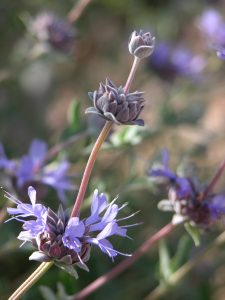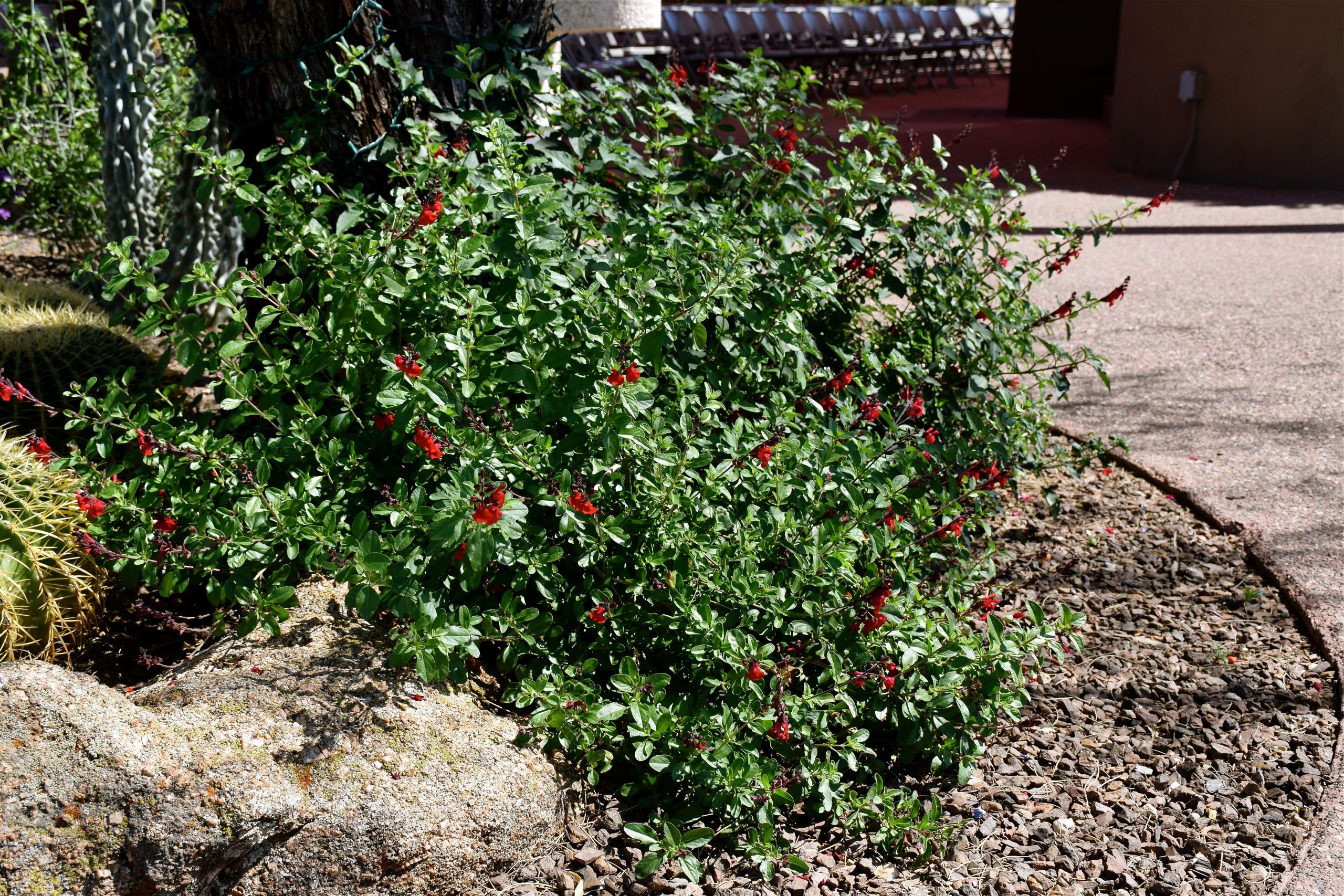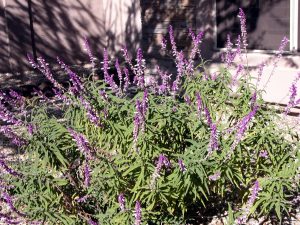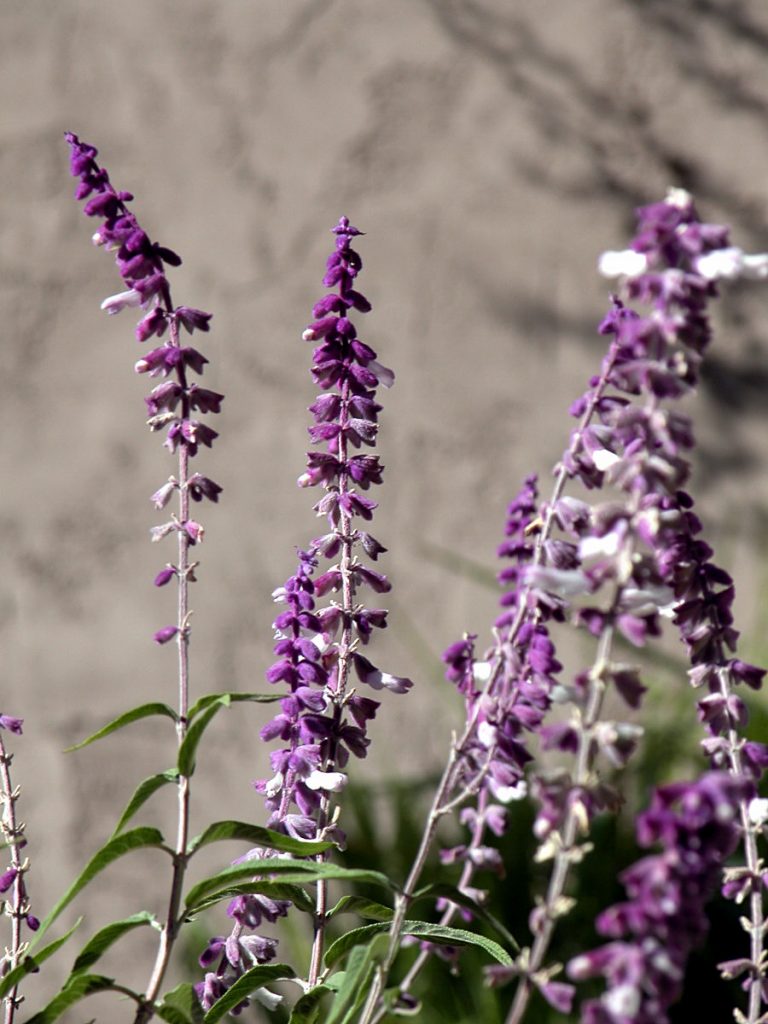With over 750 species, salvia (commonly called sage) offers a great variety of forms, foliage, and seasonal colors. Sages are known for their fragrant foliage and long-lasting, spectacular blooms. The flowers emerge above the rounded shrubs either distinctly spaced on tall skewers or in long, densely clustered spikes. Although mostly noted for their cool blue, purple, or lavender blooms, some sages produce vibrant reds, scarlet, orange, and even yellow or white blossoms. Many varieties are native to dry climates, making beautiful additions to Xeriscape gardens. Sages create excellent natural wildlife gardens that attract hummingbirds, butterflies and bees. Some have pungent aromas that discourage browsers such as rabbits. All are non-toxic and some are used medicinally, as herbs, or in teas.
Sages tolerate poor soils, but do not perform well in clay soils. They require good drainage and supplemental water in the dry summer months, and are generally adaptable to the heat and cold of the low desert. The featured varieties thrive in full sun or light shade. A good pruning after the blooming season between winter and spring keep sages neat and compact, and encourages new growth.
Depending on the size of the species, sages makes a great border or background for desert wildflowers. Planted in mass, they create a spectacular blanket of color.
 Salvia clevelandii or Chaparral Sage
Salvia clevelandii or Chaparral Sage
Chaparral sage is native to the coastal sage shrub community of California. This mounding shrub reaches 4 to 5 feet high and up to 6 feet wide, with blue-violet flowers stacked on tall vertical stems like shish-kebobs. The fragrant foliage is soft, gray-green, and wrinkled. It contrasts well with groundcovers, such as evening primrose and softens accent plants such as aloes and agaves. The flower stems are long-lasting in dry arrangements.
Salvia greggii or Autumn Sage
This small, erect shrub reaches about 3 feet high and wide, and makes a nice perennial border. Commonly seen with magenta flowers, coral, red, pink and other selections are also widely available. The fine, dark green leaves are evergreen and bushy. The branches are somewhat brittle, so this plant should not be placed in high traffic areas. Autumn sage has a long flowering season throughout the year, which is extended by trimming dead flowers. Prune as needed to maintain a compact form. Planting in filtered sun gives best results. Good drainage and supplemental water are essential.
 Salvia leucantha or Mexican Bush Sage
Salvia leucantha or Mexican Bush Sage
This graceful, perennial shrub with arching, velvety purple flower spikes has gray-green leaves with woolly white undersides and new stems. The densely clustered flower spikes are made up of a velvety purple calyx surrounding each purple or white flower. Mexican bush sage reaches about 3 feet high and wide, and is an excellent choice for the mini-oasis area of the Xeriscape garden. It may be evergreen in the warmest winters, but looks best if old flowering stems are cut back to the ground so new ones can emerge. Excess shade creates an undesirable, sprawling growth habit. This salvia does well in poor to average soils, and tolerates heavy soils better than most other salvia species.
Did you know that up to 70 percent of water use is outdoors? That’s why we love desert plants and feature them each month. It’s still a great time to plant, and you can learn more about Sages and other plants on our Arizona Low-Water-Use Plants page. Visit our page on Choosing and Planting Low Water-Use Plants for tips on plant selection and how to plant properly. Also, be sure to read through all of our featured Plant of the Month blogs!
This feature is based on a concept and text originally developed jointly by the Arizona Nursery Association and the Arizona Municipal Water Users Association (AMWUA) with partial funding from the Arizona Department of Water Resources (ADWR). Learn more about these and other great desert plants at the Arizona Municipal Water Users Association Landscape Plants for the Arizona Desert plant database.


